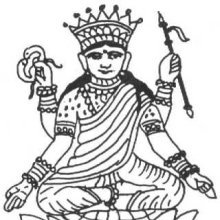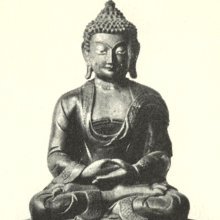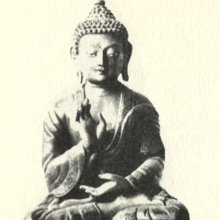Kusuma, Kusumā: 31 definitions
Introduction:
Kusuma means something in Buddhism, Pali, Hinduism, Sanskrit, Jainism, Prakrit, Marathi, Hindi, biology. If you want to know the exact meaning, history, etymology or English translation of this term then check out the descriptions on this page. Add your comment or reference to a book if you want to contribute to this summary article.
Images (photo gallery)
In Hinduism
Shaivism (Shaiva philosophy)
Source: Wisdom Library: Kubjikāmata-tantraKusumā (कुसुमा):—Name of one of the eight female deities (yoginīs) of the Yoginīcakra, according to tantric sources such as the Śrīmatottara-tantra and the Gorakṣa-saṃhita. She is also known as Kusumāyudhā. She is a variant of Kusuminī (or Kusumamālinī) who may be added as the seventh to the series of six according to the kubjikāmata-tantra. The male counterpart of Kusumā is the Bhairava named Saṃhāraka, who should be visualized mentally.
Kusumā (and the other eight yoginīs) arise forth from the body of the Bhairava named Saṃvarta, who is described as a furious deity (mahāraudra) with various fearsome characteristics. During worship, She is to be placed in a petal facing north-east. Kusumā has the head of a elephant (gaja) according to the Śrīmatottara-tantra. She has eight arms and is is greedy for flesh and liquor (piśitāsavalampaṭā). Her colour is blood-red (rudhirāruṇa).
Source: Shodhganga: Temple management in the ĀgamasKusuma (कुसुम) or Puṣpa refers to “fragrant flowers” and represents one of the various upacāras (offerings), in pūjā (ritual worship), as defined in the Śaivāgamas.—Pūjā consists of offering hospitality, in the form of water to wash the feet, to drink, water for ablutions, offering a bath, new clothes, fragrant unguents, fragrant flowers and ornaments, food and so on. Each step in the pūjā process is called “saṃskāra” and each offering is called “upacāra” [viz., Kusuma].

Shaiva (शैव, śaiva) or Shaivism (śaivism) represents a tradition of Hinduism worshiping Shiva as the supreme being. Closely related to Shaktism, Shaiva literature includes a range of scriptures, including Tantras, while the root of this tradition may be traced back to the ancient Vedas.
Purana and Itihasa (epic history)
Source: archive.org: Puranic EncyclopediaKusuma (कुसुम).—One of the five attendants given to Skandadeva by Dhātā. Kunda, Kusuma, Kumuda, Ḍambara and Āḍambara were the five attendants. (Śalya Parva, Chapter 45, Verse 39).
Source: Cologne Digital Sanskrit Dictionaries: The Purana Index1) Kusuma (कुसुम).—A Vānara chief.*
- * Brahmāṇḍa-purāṇa III. 7. 231.
2a) Kusumā (कुसुमा).—A śaktī.*
- * Brahmāṇḍa-purāṇa IV. 36. 76.
2b) The city founded by Udāyī on the south bank of the Ganges.*
- * Brahmāṇḍa-purāṇa III. 74. 132.
Kusuma (कुसुम) is a name mentioned in the Mahābhārata (cf. IX.44.35) and represents one of the many proper names used for people and places. Note: The Mahābhārata (mentioning Kusuma) is a Sanskrit epic poem consisting of 100,000 ślokas (metrical verses) and is over 2000 years old.

The Purana (पुराण, purāṇas) refers to Sanskrit literature preserving ancient India’s vast cultural history, including historical legends, religious ceremonies, various arts and sciences. The eighteen mahapuranas total over 400,000 shlokas (metrical couplets) and date to at least several centuries BCE.
Ayurveda (science of life)
Nighantu (Synonyms and Characteristics of Drugs and technical terms)
Source: Wisdom Library: Raj NighantuKusuma (कुसुम) refers to a “flower”, as mentioned in a list of eight synonyms, according to the second chapter (dharaṇyādi-varga) of the 13th-century Raj Nighantu or Rājanighaṇṭu (an Ayurvedic encyclopedia). The Dharaṇyādi-varga covers the lands, soil, mountains, jungles and vegetation’s relations between trees [viz., Kusuma] and plants and substances, with their various kinds.

Āyurveda (आयुर्वेद, ayurveda) is a branch of Indian science dealing with medicine, herbalism, taxology, anatomy, surgery, alchemy and related topics. Traditional practice of Āyurveda in ancient India dates back to at least the first millenium BC. Literature is commonly written in Sanskrit using various poetic metres.
Chandas (prosody, study of Sanskrit metres)
Source: Journal of the University of Bombay Volume V: Apabhramsa metres (2)Kusuma (कुसुम) is the name of a catuṣpadi metre (as popularly employed by the Apabhraṃśa bards), as discussed in books such as the Chandonuśāsana, Kavidarpaṇa, Vṛttajātisamuccaya and Svayambhūchandas.—Kusuma has 17 mātrās in each of their four lines, with 17 mātrās divided into groups of 4, 5, 4, 4 mātrās, where however, the third caturmātra must be of the Jagaṇa type (ISI) and the fourth must consist of 2 long letters.

Chandas (छन्दस्) refers to Sanskrit prosody and represents one of the six Vedangas (auxiliary disciplines belonging to the study of the Vedas). The science of prosody (chandas-shastra) focusses on the study of the poetic meters such as the commonly known twenty-six metres mentioned by Pingalas.
Jyotisha (astronomy and astrology)
Source: Wisdom Library: Brihat Samhita by Varahamihira1) Kusuma (कुसुम) refers to “flowers”, according to the Bṛhatsaṃhitā (chapter 5), an encyclopedic Sanskrit work written by Varāhamihira mainly focusing on the science of ancient Indian astronomy astronomy (Jyotiṣa).—Accordingly, “If the eclipses should occur before the calculated times, there will be miscarriage of pregnancy and wars in the land; if they should occur after the calculated times, flowers and fruits [i.e., kusuma-phala] will perish and there will be fear in the land and crops. I have described, as above, the effects of the occurrence of eclipses either before or after the calculated times in accordance with the ancient śāstras; but the calculation of a really learned Astronomer will at no time fail”.
2) Kusuma (कुसुम) or Puṣpa refers to the “heart-bladder”, according to the Bṛhatsaṃhitā (chapter 8).—Accordingly, “The Nakṣatras—Rohiṇī and Kṛttikā, form the body of the Vatsara Puruṣa, the two Āṣāḍhas form his navel, Āśleṣā forms the heart and Maghā, the heart-bladder [i.e., kusuma]; when benefíc planets pass through these, there will be happiness in the land; if malefic planets should pass through the body, there will be suffering from fire and winds; if they should pass through the navel, there will be suffering from starvation; if they should pass through the heart-bladder [i.e., puṣpa], roots and fruits will suffer, and if they should pass through the heart, crops will perish”.

Jyotisha (ज्योतिष, jyotiṣa or jyotish) refers to ‘astronomy’ or “Vedic astrology” and represents the fifth of the six Vedangas (additional sciences to be studied along with the Vedas). Jyotisha concerns itself with the study and prediction of the movements of celestial bodies, in order to calculate the auspicious time for rituals and ceremonies.
Kama-shastra (the science of Love-making)
Source: Shodhganga: Elements of Art and Architecture in the Trtiyakhanda of the Visnudharmottarapurana (kama)Kusuma (कुसुम) refers to “flowers”.—Cf. Taṇḍulakusumavalivikāra [= taṇḍulakusumavalivikārāḥ], which refers to “creating various designs with coloured rice grains and flowers for decorating mansions or temples”, representing one of the “sixty four kinds of Art”, according to the Kāmasūtra of Vātsyāyaṇa.—Indian tradition, basically includes sixty four Art forms are acknowledged. The references of sixty four kinds of kalā are found in the Bhāgavatapurāṇa, Śaiva-Tantras, Kāmasūtra of Vātsyāyaṇa etc.

Kamashastra (कामशास्त्र, kāmaśāstra) deals with ancient Indian science of love-making, passion, emotions and other related topics dealing with the pleasures of the senses.
In Buddhism
Tibetan Buddhism (Vajrayana or tantric Buddhism)
Source: Wisdom Library: Tibetan Buddhism1) Kusuma (कुसुम) is the name of a Pratyekabuddha mentioned as attending the teachings in the 6th century Mañjuśrīmūlakalpa: one of the largest Kriyā Tantras devoted to Mañjuśrī (the Bodhisattva of wisdom) representing an encyclopedia of knowledge primarily concerned with ritualistic elements in Buddhism. The teachings in this text originate from Mañjuśrī and were taught to and by Buddha Śākyamuni in the presence of a large audience (including Kusuma).
2) Kusumā (कुसुमा) is also the name of a Yakṣiṇī mentioned as attending the teachings in the 6th century Mañjuśrīmūlakalpa.

Tibetan Buddhism includes schools such as Nyingma, Kadampa, Kagyu and Gelug. Their primary canon of literature is divided in two broad categories: The Kangyur, which consists of Buddha’s words, and the Tengyur, which includes commentaries from various sources. Esotericism and tantra techniques (vajrayāna) are collected indepently.
In Jainism
General definition (in Jainism)
Source: archive.org: The Jaina IconographyKusuma (कुसुम) or Puṣpayakṣa is the name of the Yakṣa accompanying Padmaprabha: the sixth of twenty-four Tīrthaṃkaras or Jinas, commonly depicted in Jaina iconography.—The books of Jainism assign to the sixth Tīrthaṃkara Padmaprabha the cihna or iconographic cognizance of a red lotus. His Kevala tree is called the Chatrābha. The attendant spirits are named Kusuma and Śyāmā (Digambara: Manovegā). The chowri-bearer, generally the contemporary king, is Yamadyuti by name.
Kusuma’s characteristic symbol, according to the Śvetāmbaras and Digambaras, is an antilope. Texts of both the sects, however, diverge with regard the objects held by him. The Śvetāmbara Yakṣa will have four hands holding a fruit and Abhaya (in the right liands) and a rosary and a mongoose, (in his left hands). The Yakṣa as known to Digambaras has a lance, Varada-mudrā, shield and Abhaya-mudrā in his lour hands.
Source: archive.org: TrisastisalakapurusacaritraKusuma (कुसुम) is the name of the Yakṣa (i.e., Śāsanadevatās or ’messenger-deitiy’) associated with Padmaprabha, according to chapter 3.4 [padmaprabha-caritra] of Hemacandra’s 11th century Triṣaṣṭiśalākāpuruṣacaritra: an ancient Sanskrit epic poem narrating the history and legends of sixty-three illustrious persons in Jainism.
Accordingly:—“Originating in that congregation, Kusuma, dark-bodied, with a deer for a vehicle, holding a fruit in one right hand and the other in abhaya-position, carrying an ichneumon and a rosary in his left hands, always near, became the Lord’s messenger-deity. Acyutā, likewise originated, dark-bodied, with a man for a vehicle, one right hand holding a noose, and one in varada-position, one left hand carrying a bow, and one in abhaya-position, became a messenger-deity of the Jinendra Padmaprabha. With these two always near, the Master of the World wandered in villages, mines, cities, etc. with a desire to benefit all”.
Source: The University of Sydney: A study of the Twelve ReflectionsKusuma (कुसुम) refers to “blossom”, according to the 11th century Jñānārṇava, a treatise on Jain Yoga in roughly 2200 Sanskrit verses composed by Śubhacandra.—Accordingly, “The wishing tree of the true doctrine which is firm, whose large and very thick root has come forth from compassion for various living souls, whose twelve reflections are massive branches, which is guidance for a householder, whose excellent trunk is the way to heaven, whose splendid blossom is heavenly bliss (svargaśrī-kusuma) [and] whose fruit is virtuous inactivity, is caused to ascend by worshippers of the Jina from water in the teachings of the splendid Jinas which are richly wooded”.

Jainism is an Indian religion of Dharma whose doctrine revolves around harmlessness (ahimsa) towards every living being. The two major branches (Digambara and Svetambara) of Jainism stimulate self-control (or, shramana, ‘self-reliance’) and spiritual development through a path of peace for the soul to progess to the ultimate goal.
Biology (plants and animals)
Source: Google Books: CRC World Dictionary (Regional names)1) Kusuma in India is the name of a plant defined with Carthamus tinctorius in various botanical sources. This page contains potential references in Ayurveda, modern medicine, and other folk traditions or local practices.
2) Kusuma is also identified with Michelia champaca It has the synonym Magnolia membranacea P. Parm. (etc.).
3) Kusuma is also identified with Senna obtusifolia It has the synonym Diallobus falcatus Raf. (etc.).
4) Kusuma is also identified with Sesbania grandiflora It has the synonym Emerus grandiflorus (L.) Kuntze (etc.).
Example references for further research on medicinal uses or toxicity (see latin names for full list):
· Phytomorphology (1993)
· Life Sci. (2004)
· Acta Botanica Boreali-Occidentalia Sinica (1987)
· Methodus Plantas Horti Botanici (1794)
· Flora Indica (1832)
· Chemical and Pharmaceutical Bulletin (1910)
If you are looking for specific details regarding Kusuma, for example diet and recipes, chemical composition, extract dosage, side effects, pregnancy safety, health benefits, have a look at these references.

This sections includes definitions from the five kingdoms of living things: Animals, Plants, Fungi, Protists and Monera. It will include both the official binomial nomenclature (scientific names usually in Latin) as well as regional spellings and variants.
Languages of India and abroad
Pali-English dictionary
Source: BuddhaSasana: Concise Pali-English Dictionarykusuma : (nt.) a flower.
Source: Sutta: The Pali Text Society's Pali-English DictionaryKusuma, (nt.) any flower J. III, 394 (°dāma); V, 37; PvA. 157 (=puppha); VvA. 42; Dpvs. I, 4; Sdhp. 246, 595; Dāvs. V, 51 (°agghika), fig. vimutti° the flower of emancipation Th. 1, 100; Miln. 399. (Page 224)

Pali is the language of the Tipiṭaka, which is the sacred canon of Theravāda Buddhism and contains much of the Buddha’s speech. Closeley related to Sanskrit, both languages are used interchangeably between religions.
Marathi-English dictionary
Source: DDSA: The Molesworth Marathi and English Dictionarykusuma (कुसुम).—n S A flower.
Source: DDSA: The Aryabhusan school dictionary, Marathi-Englishkusuma (कुसुम).—n A flower.
Marathi is an Indo-European language having over 70 million native speakers people in (predominantly) Maharashtra India. Marathi, like many other Indo-Aryan languages, evolved from early forms of Prakrit, which itself is a subset of Sanskrit, one of the most ancient languages of the world.
Sanskrit dictionary
Source: DDSA: The practical Sanskrit-English dictionaryKusuma (कुसुम).—
1) A flower; उदेति पूर्वं कुसुमं ततः फलम् (udeti pūrvaṃ kusumaṃ tataḥ phalam) Ś.7.3.
2) Menstrual discharge.
3) A fruit.
4) A disease of the eyes.
-maḥ A form of fire.
Derivable forms: kusumam (कुसुमम्).
Source: Cologne Digital Sanskrit Dictionaries: Edgerton Buddhist Hybrid Sanskrit DictionaryKusuma (कुसुम).—(1) lit. flower, used in composition Laṅkāvatāra-sūtra 43.15, kusuma-dharma-paryāya, lit. flower (of a) dharma-p°, i.e. supreme, beautiful, noble one? Tibetan renders literally; Suzuki most subtle doctrine (does ‘most subtle’ represent kusuma?); (2) name of two future Buddhas: dvau buddhau kusumanāmau (°nāmānau) Mahāvastu ii.355.8 = iii.279.13; name of a future Buddha, Gaṇḍavyūha 441.25; followed by Kusumaśrī, the two corresponding to Mahāvastu's two Kusumas (on the passage see s.v. Maitreya); (3) name of a king, former incarnation of Śākyamuni: Rāṣṭrapālaparipṛcchā 24.10.
--- OR ---
Kusumā (कुसुमा).—name of a legendary queen, instructed and saved by Buddha (wife of Kusumbha): Mahāvastu i.177.14; 180.14, 17; 181.7 ff.
Source: Cologne Digital Sanskrit Dictionaries: Shabda-Sagara Sanskrit-English DictionaryKusuma (कुसुम).—n.
(-maṃ) 1. A flower in general. 2. Fruit. 3. The menstrual discharge. 4. Ophthalmia, disease of the eyes. E. kus to shine, uma Unadi aff.
Source: Cologne Digital Sanskrit Dictionaries: Benfey Sanskrit-English DictionaryKusuma (कुसुम).—[ku-suma], probably, ku-smi + a, n. A flower, [Mānavadharmaśāstra] 11, 70.
Source: Cologne Digital Sanskrit Dictionaries: Cappeller Sanskrit-English DictionaryKusuma (कुसुम).—[neuter] flower, bud.
Source: Cologne Digital Sanskrit Dictionaries: Monier-Williams Sanskrit-English Dictionary1) Kusuma (कुसुम):—n. ([from] √kus, [Uṇādi-sūtra]; [gana] ardharcādi), a flower, blossom, [Manu-smṛti xi, 70; Rāmāyaṇa] etc. (ifc. f(ā). ), [Mālavikāgnimitra] & [Ratnāvalī]
2) Name of the shorter sections of Deveśvara’s Kavi-kalpa-latā (the longer chapters being called stabaka)
3) fruit, [cf. Lexicographers, esp. such as amarasiṃha, halāyudha, hemacandra, etc.]
4) the menstrual discharge, [cf. Lexicographers, esp. such as amarasiṃha, halāyudha, hemacandra, etc.]
5) a particular disease of the eyes, [cf. Lexicographers, esp. such as amarasiṃha, halāyudha, hemacandra, etc.]
6) m. a form of fire, [Harivaṃśa 10465]
7) Name of an attendant of the sixth Arhat of the present Avasarpiṇī, [cf. Lexicographers, esp. such as amarasiṃha, halāyudha, hemacandra, etc.]
8) Name of a prince, [Buddhist literature]
Source: Cologne Digital Sanskrit Dictionaries: Yates Sanskrit-English DictionaryKusuma (कुसुम):—(maṃ) 1. n. A flower or fruit; menses; ophthalmia.
Source: DDSA: Paia-sadda-mahannavo; a comprehensive Prakrit Hindi dictionary (S)Kusuma (कुसुम) in the Sanskrit language is related to the Prakrit words: Kasuma, Kusuma.
[Sanskrit to German]
Sanskrit, also spelled संस्कृतम् (saṃskṛtam), is an ancient language of India commonly seen as the grandmother of the Indo-European language family (even English!). Closely allied with Prakrit and Pali, Sanskrit is more exhaustive in both grammar and terms and has the most extensive collection of literature in the world, greatly surpassing its sister-languages Greek and Latin.
Hindi dictionary
Source: DDSA: A practical Hindi-English dictionaryKusuma (कुसुम) [Also spelled kusum]:—(nm) a flower.
...
Prakrit-English dictionary
Source: DDSA: Paia-sadda-mahannavo; a comprehensive Prakrit Hindi dictionaryKusuma (कुसुम) in the Prakrit language is related to the Sanskrit word: Kusuma.
Prakrit is an ancient language closely associated with both Pali and Sanskrit. Jain literature is often composed in this language or sub-dialects, such as the Agamas and their commentaries which are written in Ardhamagadhi and Maharashtri Prakrit. The earliest extant texts can be dated to as early as the 4th century BCE although core portions might be older.
Kannada-English dictionary
Source: Alar: Kannada-English corpusKusuma (ಕುಸುಮ):—
1) [noun] a flower a) the reproductive organ in a plant containing one or more pistils or stamens or both, and usu. a corolla and calyx, and from which the fruit or seed develops; b) such an organ when brightly coloured and conspicuous; a blossom, a bloom.
2) [noun] any of the parts of the corolla of a flower; a petal.
3) [noun] a small juicy pulp as found in some edible fruits fruits as orange, lime etc.
4) [noun] the periodic discharge from the womb of a woman; the menses.
5) [noun] the grass Saccharum spontaneum of Poaceae family, that resembles sugar-cane; thatch grass.
6) [noun] religious defilement caused by menses.
7) [noun] a Kannaḍa meter having six lines of which third and sixth have three groups of five units each followed by a long one and the rest have two groups of five units each.
8) [noun] a Vedic meter having four lines each having eleven syllables.
9) [noun] the edible plant-structure of a mature ovary of a flowering plant; a fruit.
10) [noun] a disease of the eye.
11) [noun] a usu. hereditary disorder with a tendency to bleed severely from even a slight injury, through the failure of the blood to clot normally; haemophilia.
12) [noun] a thick, sweet, syrupy substance that bees make as food from the nectar of flowers and store in honeycombs; honey.
Kannada is a Dravidian language (as opposed to the Indo-European language family) mainly spoken in the southwestern region of India.
See also (Relevant definitions)
Starts with (+127): Kucumakaram, Kucumam, Kucumantar, Kusuma arati, Kusuma chettu, Kusumabana, Kusumabanavilasa, Kusumabha, Kusumabhava, Kusumabhijna, Kusumacapa, Kusumachapa, Kusumachita, Kusumachuda, Kusumacita, Kusumacuda, Kusumacula, Kusumadama, Kusumadanta, Kusumadayin.
Ends with (+94): Adinakusuma, Agastyakusuma, Akalakusuma, Akashakusuma, Akusuma, Ambarakusuma, Anandakusuma, Anangakusuma, Apsarahkusuma, Atasikusuma, Avakirnakusuma, Banakusuma, Barhikusuma, Bisakusuma, Brihatikusuma, Campakakusuma, Canakyakusuma, Candakusuma, Candikusuma, Champakakusuma.
Full-text (+243): Kusumayudha, Kusumasava, Kusumavatamsaka, Kusumacita, Kusumita, Kusumatmaka, Kusumavacaya, Kusumapura, Kusumeshu, Kusumanjana, Kusumastra, Devakusuma, Kusumadhipa, Kusumakara, Kusumadhiraj, Sugandhikusuma, Gandakusuma, Nilakusuma, Japakusumam, Kusumamaya.
Relevant text
Search found 48 books and stories containing Kusuma, Kusumā; (plurals include: Kusumas, Kusumās). You can also click to the full overview containing English textual excerpts. Below are direct links for the most relevant articles:
The Mahavastu (great story) (by J. J. Jones)
Chapter XIX - Apparitions (for the edification of men) < [Volume I]
Chapter XXIV - After the enlightenment < [Volume III]
Chapter XXX - The second Avalokita-sūtra < [Volume II]
Bhakti-rasamrta-sindhu (by Śrīla Rūpa Gosvāmī)
Verse 4.1.10 < [Part 1 - Laughing Ecstasy (hāsya-rasa)]
Verse 3.3.113 < [Part 3 - Fraternal Devotion (sakhya-rasa)]
Verse 4.8.79 < [Part 8 - Compatible & Incompatible Mellows (maitrī-vaira-sthiti)]
The backdrop of the Srikanthacarita and the Mankhakosa (by Dhrubajit Sarma)
Part 5p - Alaṃkāra (16): Viṣama or incongruity < [Chapter III - Literary Assessment Of The Śrīkaṇṭhacarita]
Vakyapadiya of Bhartrihari (by K. A. Subramania Iyer)
Verse 3.14.25 < [Book 3 - Pada-kāṇḍa (14): Vṛtti-samuddeśa (On Ccomplex Formation)]
Garga Samhita (English) (by Danavir Goswami)
Verse 3.8.6 < [Chapter 8 - The Opulences of Śrī Girirāja]
Verse 1.14.41 < [Chapter 14 - The Liberation of Śakaṭāsura and Tṛṇāvarta]
Verse 3.7.8 < [Chapter 7 - The Holy Places of Śrī Girirāja]
Related products






